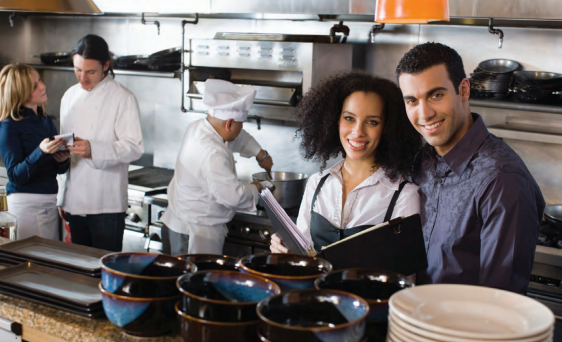
No matter what type of dining concept you may be developing, every restaurant facility should keep in mind the safety of patrons and employees. In addition, restaurateurs should consider taking steps toward environmental health. The design of a commercial kitchen has a direct impact on the health and safety of the public. Identify the minimum environmental health requirements you need to operate, and incorporate them into the design phase. Addressing these items earlier rather than later can save you time and money.
Please note: This article addresses basic requirements that apply in most cases. Consult with building code and health department officials in the appropriate jurisdiction for specific information.
Cleaning Needs
Sinks are major components in restaurants and should be designated for food preparation, cleaning or hand washing.
For example, a one or two compartment sink with an attached drain board is necessary to clean meat and produce; in some cases, two separate sinks for meat and produce are required. A three compartment sink with attached drain boards on both sides is necessary for cleaning pots, pans and utensils.
For hand washing, a restaurant likely needs two or more sinks. Hand sinks should be strategically located so they are approximately 15’ (maximum) walking distance from any service area; this limits travel distances for employees.
Finally, a single mop sink is sufficient for a restaurant. Mop sinks are typically floor-based and supplied with hot and cold domestic water. The adjacent area should have mops, buckets and other cleaning agents for easy access.
Although not specifically required by health departments, automatic dishwashers are commonly used in restaurants and are often preferred over manual cleaning. Not only do they have short running cycles, making them efficient and economic, but dishwashers also reach extremely high temperatures to promote better hygiene and sanitation.
Refrigeration and Ventilation
Refrigeration equipment is a necessity for all restaurants. While health departments typically require one freezer and one refrigerator, many options are available to suit any restaurant’s needs. For example, provided there is ample space and restaurant capacity, a walk-in refrigerator and/or freezer stores larger amounts of food with a longer shelf life, greatly reducing food costs.
An exhaust hood above the cooking line contains fans, filters and other components. The hood’s purpose is to remove airborne grease, combustion products, smoke, odors, heat and steam through a combination of air filtration and evacuation. Most jurisdictions require that exhaust hoods be fitted with a fire suppression system. Note that exhaust hoods can be one of the larger and more costly pieces of restaurant equipment, but they are required more often than not.
Restrooms
Restrooms are an essential part of any restaurant establishment. If the restaurant is strictly a takeout establishment, then an employee restroom is sufficient; however, if a restaurant offers dine-in service, restrooms should be accessible to employees and patrons. The number of restrooms required is determined by the total occupancy count of the restaurant, and the restroom fixture count is divided into male and female restrooms, since unisex restrooms are rare. Other restroom requirements include soap, a means of hand drying and trash receptacles. Bear in mind that there are also handicap accessible requirements for restrooms, as well as entire restaurants.
Surface Areas
Health departments are also concerned about interior finishes in restaurant service areas. Kitchen flooring, for instance, should be nonporous and easy to clean; quarry or ceramic tile works well in floor and cove base areas. Walls should be washable; glossy paint on drywall may work, but plastic wall panels or glazed ceramic tiles are better. Behind the cooking line, a stainless steel wall panel is best; it resists grease. Like walls, ceilings above all kitchen areas should be washable. Regular ceiling tiles are inappropriate in commercial kitchens because of their porous quality and inability to withstand moisture. Typically, drywall with a gloss paint finish or special ceiling tiles are acceptable. Additionally, ceiling-mounted lights should have a protective shield—this prevents broken glass from appearing in the soup!
Trapping Grease
Grease traps or grease interceptors are plumbing devices used to catch kitchen grease and solids before they enter the municipal wastewater system. Most municipalities require them for any type of restaurant establishment because fats and oils are problematic for the municipal treatment facility.
Two major types of grease traps are used today: an interior application that sits adjacent to the sink or sinks and has a capacity of about 50 gallons; and an exterior grease trap, made of concrete and concealed underground with an approximate capacity of 1,500 pounds. Many jurisdictions now require a grease trap of 1,500 pounds minimum capacity, regardless of restaurant size. Because grease traps can be a relatively costly item, learn the local requirements in advance.
Even with increasing environmental health regulations for commercial kitchens, restaurateurs still have the freedom to incorporate any cooking equipment they need to accommodate their restaurant’s goals. Good health and safety practices during the design phase will help make any restaurant concept a reality.














